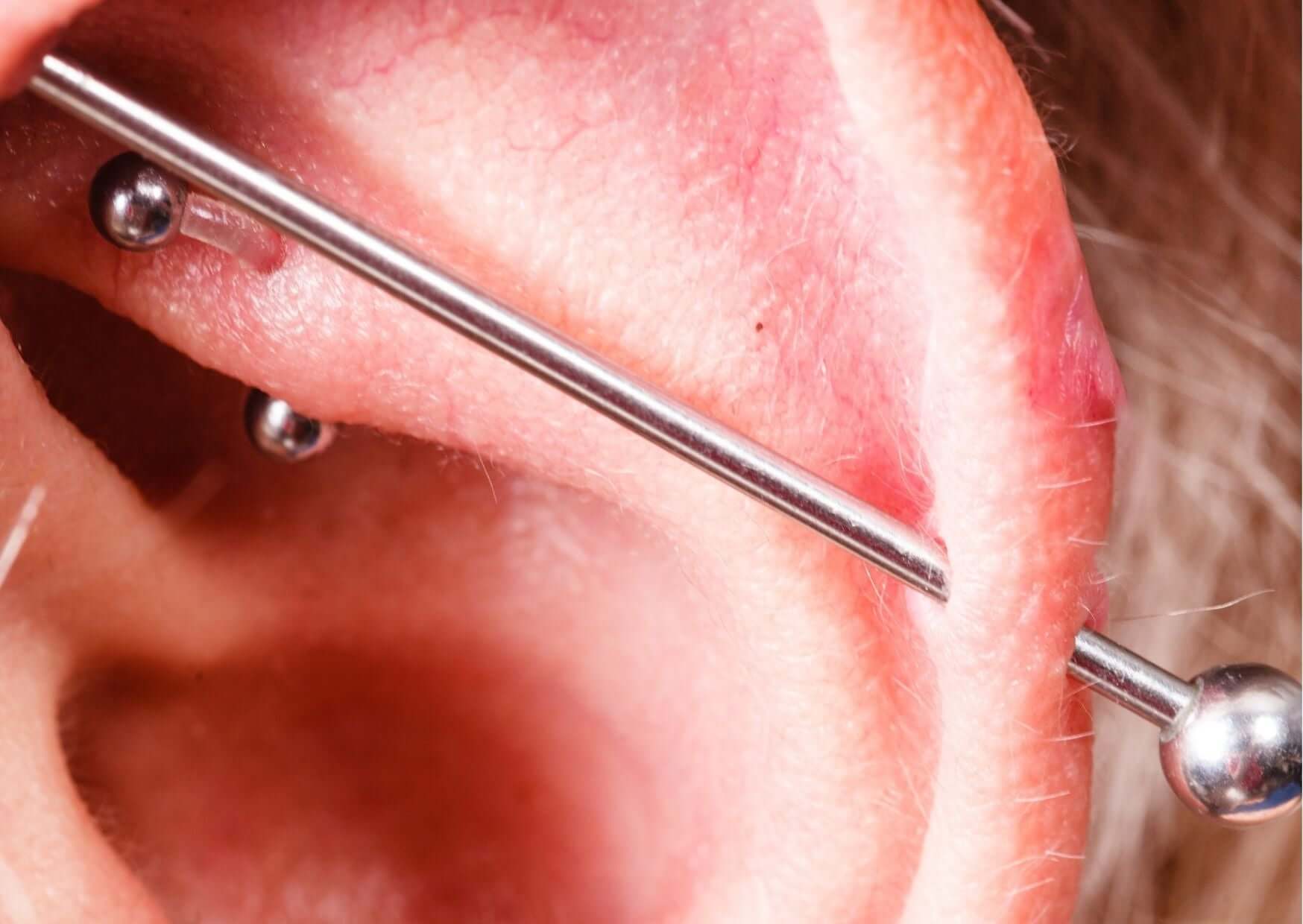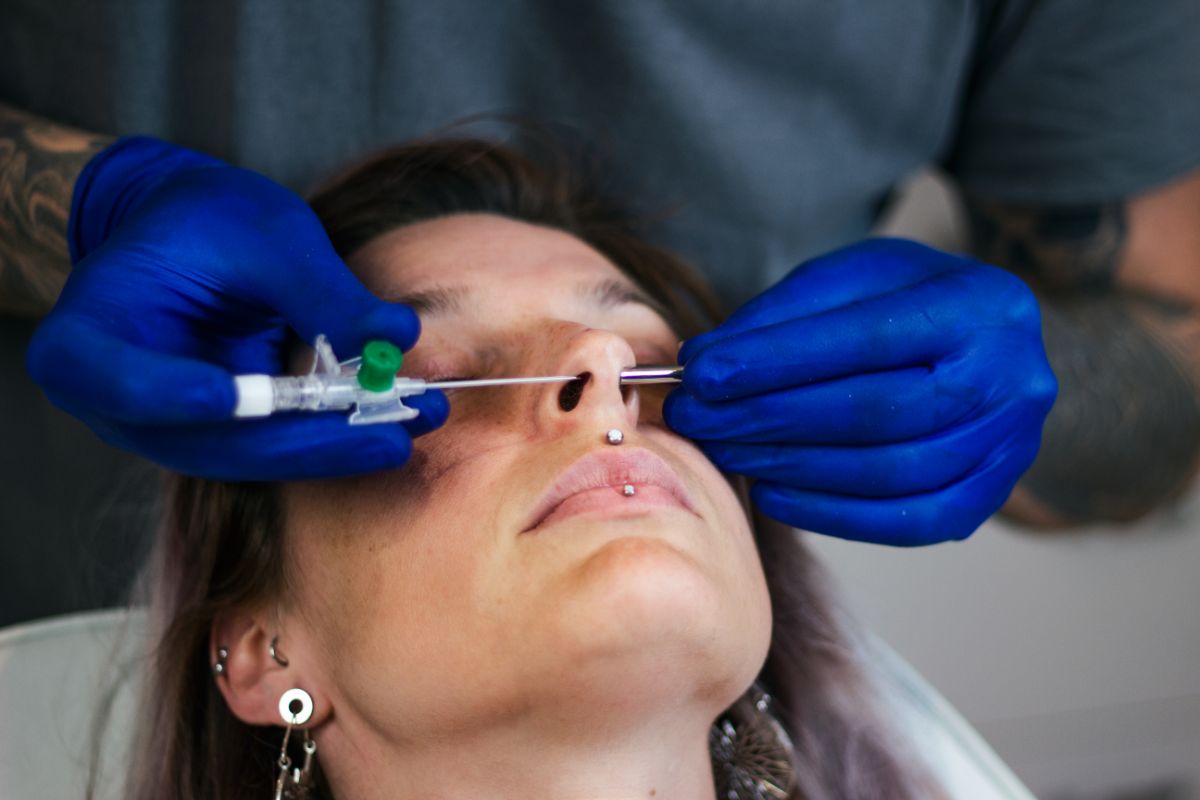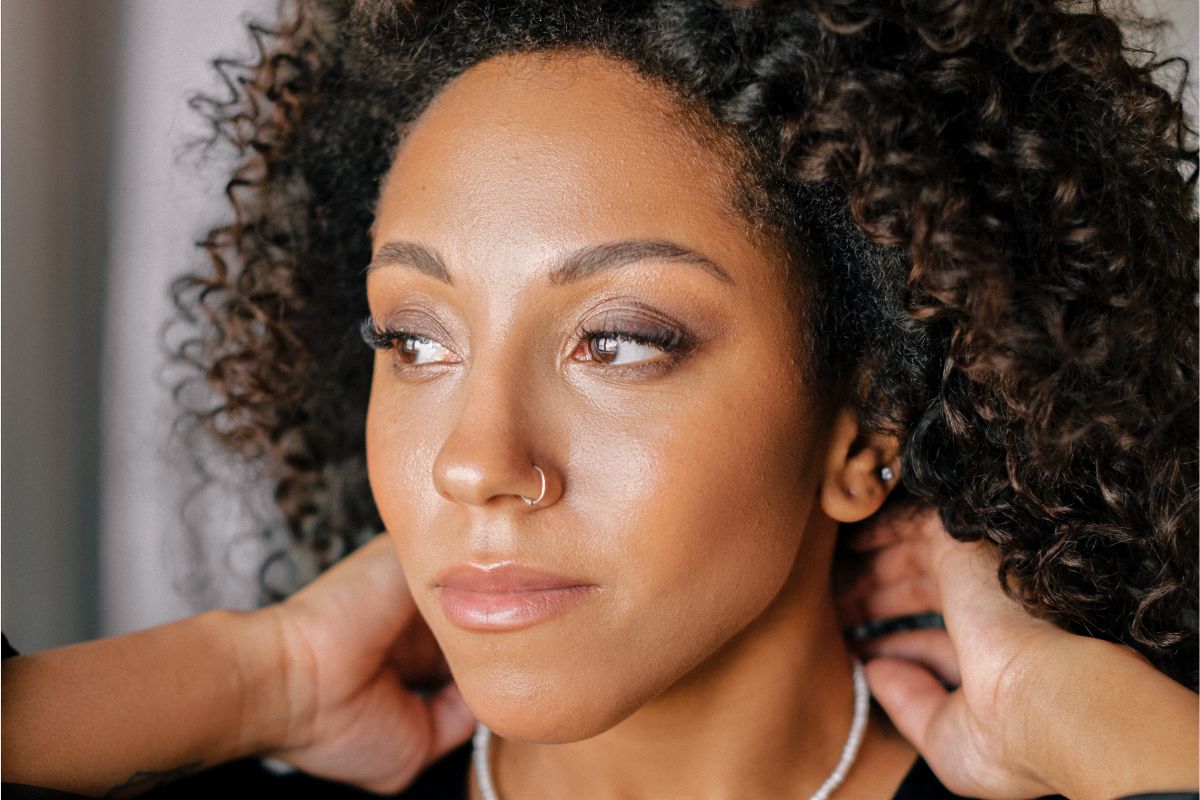Piercings are undoubtedly beautiful. They are a unique form of artistic self-expression, which explains why people can never get enough of them. It’s not unusual to see men and women sporting multiple piercings.
These days, you’ll find them getting piercings on different parts of their bodies. According to Stephanie Hutter-Thomas, a professional body piercer, piercings have a psychological effect on people causing them to become addicted to getting more.
In fact, there are so many of them that artists have given them unique names. One of the most popular piercings is industrial piercing. If you’re thinking about getting an industrial piercing, make sure you know how to care for it. Although piercings are pretty to look at, they can cause a great deal of stress if they get infected.

What Is an Industrial Piercing?
An industrial piercing is a piercing through your ear’s cartilage. It has two different points of entry and exit. Usually, a bar-shaped jewelry piece is used to connect the two piercings. Industrial piercings are unique and eye-catching, but it has a downside. According to research, this type of piercing is prone to infection.
Why Are Industrial Piercings Susceptible to Infection?
All types of piercings are prone to develop an infection, but medical doctors have found that industrial piercings are more likely to get infected compared to other piercing types for three reasons.
One, you’re getting two holes instead of one, and this doubles your risk. Two, since the piercings are located in the cartilage, and the cartilage takes much longer to heal, the risk for infection heightens.
And third, this type of piercing is close to your hair. Dirt, oil, and bacteria from your hair can easily travel to your piercings. Plus, if you have long hair, there’s a tendency for some of the strands to get caught and tangled in your jewelry, causing irritation.
What Does an Infected Industrial Piercing Look and Feel Like?
If you’re planning to get industrial piercings, you have to be aware of the potential signs and symptoms of infection. Mild irritation is expected during the first few days since your skin is still adjusting to the holes.
During the first seven to fourteen days, it’s normal to experience mild swelling, redness, slight warmth on the areas affected, throbbing, and seeing a white or clear discharge coming out of the holes.
If the swelling or redness around your piercings worsens over time, that’s your cue to call a doctor. These are the first signs of infection. Other signs of infection include the following:
- Swelling that gets worse
- Persistent warmth
- Severe pain
- Pus
- Fever
- Excessive bleeding
- Bump at the back or front of the holes
What Can Happen If Your Ear Piercings Get Infected?
If your industrial piercings get infected, and you’re not doing anything about it, the infection will only get worse. An abscess may form, especially in the upper ear piercings.
Without treatment, the infection can penetrate into your bloodstream and spread all throughout your body resulting in a life-threatening systemic infection. There’s also a tendency for your piercings to close up following an infection.
Are Your Industrial Piercings Infected?
They say it takes several months for feelings of excitement to dwindle. Now that you finally have the courage to give industrial piercings a try, you’re left worried and anxious instead of savoring the excitement because you’re slowly becoming aware that your piercings are showing signs of infection.
What went wrong? There are several factors that could potentially be the reasons why your ears go infected.
#1 Unsanitary Environment
Ideally, a professional body piercing studio should follow rigorous hygiene standards. This is a must since they offer invasive services.
To ensure their customers do not get infected, they should wear gloves and wash their hands regularly. It’s also important to disinfect the area. The instruments and tools used should also be sterilized, especially the needles.
#2 Touching Your Piercings
We know how much you love your new piercings but as much as possible, keep your dirty hands away from them. Even if you washed your hands, it’s still a big no-no. Leave them alone otherwise, and if you continue to touch them, you might cause them to get irritated. Every time you put on jewelry, make sure your hands are clean.
#3 Irritating Your Piercings
If your jewelry gets caught in your hair or in your clothes or if you accidentally bumped into something that hurt your ear, there’s a possibility that your piercings can get irritated and inflamed, making them prone to infection.
Believe it or not but even if it has been years since your last piercing and even though they’ve completely healed, injuries can still cause irritation and instigate an infection.
#4 Using Cheap Jewelry
You might think you’re saving money by buying cheap acrylic or metal jewelry, but you’re wrong. Did you know that cheap metal can result in infection? There are people who are sensitive to cheap metal, and if you’re one of those, we discourage you from buying them.
If you’re the type who’s allergic to certain metals, your body will trigger an allergic reaction, and this will increase your likelihood of developing an infection.
Allergies can also cause the site to itch, and if you scratch it with your hands, which are by the way teeming with bacteria, infection will be just around the corner.
#5 Improper Cleaning
Cleaning your piercings is a must. Even if the sites have completely healed, you still need to clean them regularly. Keeping your piercings clean will prevent bacteria and germs from causing an infection. And yes, you still need to clean your piercings even if the skin that surroundings appear clean.
How Do You Prevent Industrial Piercing Infections?
There are cases where infections can be treated at home, but if the symptoms get worse or if this is your first time to encounter a piercing infection, the best you can do is to let your piercer know about it.
But don’t get discouraged. If you’re excited to get your ears pierced, go ahead and do it! Albeit infection is possible, you can prevent it from happening by doing the following:
1. Avoid Touching Your Jewelry
During the first few weeks, it can be tempting to play or touch your jewelry. It may be out of habit, curiosity, or boredom. Regardless of the reason, you should avoid touching the area.
Resist the urge because if you continue to do so, the irritation and swelling will only get worse. Not only that, but you’re also introducing harmful bacteria to the site. Once the piercings are made, they should be off-limits except when you’re cleaning them.
2. Clean the Sites Regularly
If you want to keep your piercings infection-free for as long as possible, you should strive to clean the sites at least two to three times a day or as instructed by your piercer for several months after you get your ears pierced. The cleansing solution of choice by most experts is a saline solution.
If you are already exhibiting early signs of infection, cleansing the site on a regular basis will stop the infection from getting worse.
No matter how busy you are, always make time to clean your piercings. The efforts you’re making will eventually pay off.
3. Apply Warm Compress
Regularly applying a warm compress over the site will help expedite wound healing. Studies show that warm compress helps lessen irritation, relieves pain, and minimizes swelling.
You can use a clean damp towel and place it inside the microwave and heat it for thirty seconds, or you can purchase compresses in stores. Usually, these compresses have rice grains or herbs inside to seal the warmth.
They also promise to provide swelling and pain relief. Apply the compress to the site at a twenty-minute interval twice a day.
If you’re going to make your own warm compress, just make sure that the cloth is properly sealed just in case you plan to put grains or herbs inside so they won’t fall out.
You may also give chamomile compress a try. Research suggests that applying chamomile compress will help speed up the healing process. Chamomile is best known for its anti-inflammatory and antioxidant properties.
But, before you apply chamomile over your piercings, make sure you’re not allergic to it. To test if you’re not allergic, do a patch test. Here’s how you can do it.
- Place a steeped tea bag carefully on the inside of your elbow.
- After three minutes, take the teabag out. Don’t rinse the area just yet. Let it air dry.
- If within twenty-four hours you do not experience inflammation or irritation on the site, then it means you’re not allergic to chamomile, and you can then go ahead and make a chamomile compress.
How to Make Chamomile Compress:
- Steep two chamomile tea bags in boiling water for approximately five to seven minutes.
- After five minutes, take the bags out and let them cool for thirty seconds.
- Take a paper towel and carefully wrap each teabag. The purpose of wrapping the bags in the paper towel is to ensure that the string doesn’t get tangled to the jewelry upon application.
- Place the chamomile compress over each hole for ten minutes. If it starts to cool, you may place them again in warm water.
- Once you’re done, rinse the holes with warm water and then pat them dry using a clean towel.
- Repeat the process every day.
4. Spread Diluted Tea Tree Oil Over The Holes
Tea tree oil is famed for its antimicrobial properties, making it useful for cleaning and disinfecting piercings. Don’t directly apply the oil over your skin. You must dilute it with saline or carrier oil.
Use the same amount of saline to dilute the oil. Diluting the oil is very important because if you apply pure oil over the area, it will cause irritation.
Before applying tea tree oil on your piercings, you should check if you’re not allergic to it. To check, do a patch test. Here’s how to do a patch test:
- Mix the saline and tea tree oil and rub the mixture on the inside of your elbow.
- Give it twenty-four hours. Wait and see if the inside of your elbow will show irritation, redness, or itchiness. If you don’t experience any untoward reaction, then it’s pretty much safe to apply tea tree oil on your piercings.
You can add a couple of drops of diluted tea tree oil and make it part of your cleaning process, or you can use it as a spot treatment after cleansing. Get a clean paper towel and dip it in the mixture. Apply it over the front and back holes two times a day.
5. Apply Aftercare Swabs
You can find aftercare swabs sold in pharmacies. These medicated swabs also help disinfect the area and protect your piercings against bacterial infection. One of the most talked-about swabs the are uniquely designed for cleaning piercings is Dr. Piercing Aftercare.
The wonderful thing about these pre-packed swabs is you no longer have to mix your own solutions because everything is prepared for you. All you need is to open the seal, and voila! You’re good to go.
Takeaway
Accessorizing with jewelry will instantly elevate your look and make you even more attractive, but if you don’t strictly follow aftercare instructions, those attractive piercings will become infected, leaving you with red, inflamed, and itchy ears. Beyond aesthetics, the infection will also compromise your health.

Are You Looking for Effective Industrial Piercing Swabs?
At Dr. Piercing Aftercare, we’ve developed convenient medicated swabs that will clean your piercings and keep infection at bay. We take pride in our products as they are made and tested in a cGMP compliant, and FDA registered facility in America.
The swabs we’ve created are packed using advanced technology for easy application. Each of our packs contains thirty-six medicated swabs that are proven and tested to promote your body’s natural healing process while preventing infection. Contact us today, or you can check out our website if you want to learn more about our products.





